Understanding the Synergistic Effects of Walking Accessibility and the Built Environment on Street Vitality in High-Speed Railway Station Areas
Abstract
1. Introduction
- How do we define and quantify street vitality in the HSR station areas based on GPS data?
- What factors may influence street vitality in the HSR station areas?
- Are the impacts of different factors on street vitality independent or synergistic?
2. Literature Review
2.1. Space Development of High-Speed Railway Station Areas
2.2. Influencing Factors of the Street Vitality around the Station
3. Study Area and Data Description
3.1. Study Area
3.2. Data Description
3.2.1. GPS Data
3.2.2. Point-of-Interest Data
4. Method
4.1. Identification of HSR Passengers
- The GPS data were cleaned and preprocessed, which included removing duplicates, handling missing values, and converting timestamps to a usable format.
- The GPS tracks were divided into segments based on time and space to analyze the passenger’s journey. Then, the average speed of the passengers was calculated based on the time and distance of each segment. Speeds above a certain threshold will be identified as high-speed railway speeds.
- Station identification was achieved by comparing the passenger’s passing point with the HSR station. The daily trips of HSR passengers shall include intracity trips from the origin to the departure HSR station, intercity trips from the departure HSR station to the arrival HSR station, and intracity trips from the arrival HSR station to the destination, as shown in Figure 4.
- Result verification was also required. Additional information, such as the ticket purchase record, will be used to confirm the passenger’s identity.
4.2. Definition and Quantification of Variables
4.2.1. Definition and Quantification of Street Vitality
4.2.2. Quantification of Built Environment Characteristics
4.3. Modeling Approach
5. Result and Discussion
5.1. Model Validation
- N_estimators: the number of decision trees.
- Learning rate: the step size shrinkage used in the update to prevent overfitting.
- Max_depth: the maximum depth of a tree.
- Subsample: a parameter that controls the proportion of random samples for each tree.
- Colsample_bytree: a family of parameters for the subsampling of columns.
5.2. Relative Importance of Explanatory Variables
5.3. Synergistic Effects of Explanatory Variables on Street Vitality
5.3.1. Walking Accessibility and Built Environment Characteristics
5.3.2. Two-Variable Built Environment Characteristics
6. Conclusions
Author Contributions
Funding
Institutional Review Board Statement
Informed Consent Statement
Data Availability Statement
Conflicts of Interest
References
- Tang, M.; Sun, H. China’s High-Speed Railway Development History. In High-Speed Rail: An Analysis of the Chinese Innovation System; World Scientific: Singapore, 2020; pp. 385–424. [Google Scholar]
- Xu, F. The Belt and Road: The Global Strategy of China High-Speed Railway; Springer: Berlin/Heidelberg, Germany, 2018. [Google Scholar]
- Diao, M.; Zhu, Y.; Zhu, J. Intra-city access to inter-city transport nodes: The implications of high-speed-rail station locations for the urban development of Chinese cities. Urban Stud. 2017, 54, 2249–2267. [Google Scholar] [CrossRef]
- Wu, R.; Li, Y.; Wang, S. Will the construction of high-speed rail accelerate urban land expansion? Evidences from Chinese cities. Land Use Policy 2022, 114, 105920. [Google Scholar] [CrossRef]
- Jażdżewska, I.; Kotlicka, J. Application of Cluster Analysis in Urban Morphology Research. The Example of Industrial Plots in Łódź (Poland). Folia Geogr. 2020, 62, 5–21. [Google Scholar]
- Wang, F.; Liu, Z.; Xue, P.; Dang, A. High-speed railway development and its impact on urban economy and population: A case study of nine provinces along the Yellow river, China. Sustain. Cities Soc. 2022, 87, 104172. [Google Scholar] [CrossRef]
- Yin, M.; Bertolini, L.; Duan, J. The effects of the high-speed railway on urban development: International experience and potential implications for China. Prog. Plan. 2015, 98, 1–52. [Google Scholar] [CrossRef]
- Kecskés, T.; Kozma, G. City centre residents’ opinion about inner quarter’s renewal—A central european case study. Folia Geogr. 2020, 62, 95. [Google Scholar]
- Kamruzzaman, M.; Baker, D.; Washington, S.; Turrell, G. Advance transit oriented development typology: Case study in Brisbane, Australia. J. Transp. Geogr. 2014, 34, 54–70. [Google Scholar] [CrossRef]
- Du, J.; van Wesemael, P.; Druta, O. Place quality in high-speed rail station areas. J. Transp. Land Use 2021, 14, 1165–1186. [Google Scholar] [CrossRef]
- Dai, G. Place-Making around High-Speed Railway Stations in China; Universiteit van Amsterdam: Amsterdam, The Netherlands, 2015. [Google Scholar]
- Liu, D.; Shi, Y. The influence mechanism of urban spatial structure on urban vitality based on geographic big data: A case study in downtown Shanghai. Buildings 2022, 12, 569. [Google Scholar] [CrossRef]
- Yue, W.; Chen, Y.; Zhang, Q.; Liu, Y. Spatial explicit assessment of urban vitality using multi-source data: A case of Shanghai, China. Sustainability 2019, 11, 638. [Google Scholar] [CrossRef]
- Wu, W.; Niu, X. Influence of built environment on urban vitality: Case study of Shanghai using mobile phone location data. J. Urban Plan. Dev. 2019, 145, 04019007. [Google Scholar] [CrossRef]
- Monzón, A.; Ortega, E.; López, E. Efficiency and spatial equity impacts of high-speed rail extensions in urban areas. Cities 2013, 30, 18–30. [Google Scholar] [CrossRef]
- Liang, Y.; Zhou, K.; Li, X.; Zhou, Z.; Sun, W.; Zeng, J. Effectiveness of high-speed railway on regional economic growth for less developed areas. J. Transp. Geogr. 2020, 82, 102621. [Google Scholar] [CrossRef]
- Yang, H.; Fu, M.; Wang, L.; Tang, F. Mixed land use evaluation and its impact on housing prices in beijing based on multi-source big data. Land 2021, 10, 1103. [Google Scholar] [CrossRef]
- de Dios Ortúzar, J.; Willumsen, L.G. Modelling Transport; John Wiley & Sons: Hoboken, NJ, USA, 2024. [Google Scholar]
- Axhausen, K.W.; Zimmermann, A.; Schönfelder, S.; Rindsfüser, G.; Haupt, T. Observing the rhythms of daily life: A six-week travel diary. Transportation 2002, 29, 95–124. [Google Scholar] [CrossRef]
- Stopher, P.R.; Greaves, S.P. Household travel surveys: Where are we going? Transp. Res. Part A Policy Pract. 2007, 41, 367–381. [Google Scholar] [CrossRef]
- Niu, Q.; Wang, Y.; Xia, Y.; Wu, H.; Tang, X. Detailed assessment of the spatial distribution of urban parks according to day and travel mode based on web mapping API: A case study of main parks in Wuhan. Int. J. Environ. Res. Public Health 2018, 15, 1725. [Google Scholar] [CrossRef]
- Sadoun, B.; Al-Bayari, O.; Al-Rawashdeh, S. The development of a web mapping system and its application. In Proceedings of the International Conference on e-Business, Seville, Spain, 18–21 July 2011; IEEE: Piscataway, NJ, USA, 2011; pp. 1–7. [Google Scholar]
- Yeow, L.W.; Low, R.; Tan, Y.X.; Cheah, L. Point-of-Interest (POI) data validation methods: An urban case study. ISPRS Int. J. Geo-Inf. 2021, 10, 735. [Google Scholar] [CrossRef]
- Peng, J.; Hu, Y.; Liang, C.; Wan, Q.; Dai, Q.; Yang, H. Understanding nonlinear and synergistic effects of the built environment on urban vibrancy in metro station areas. J. Eng. Appl. Sci. 2023, 70, 18. [Google Scholar] [CrossRef]
- Yang, J.; Su, P.; Cao, J. On the importance of Shenzhen metro transit to land development and threshold effect. Transp. Policy 2020, 99, 1–11. [Google Scholar] [CrossRef]
- Zou, Z.; Tang, Y. Evaluation of Sustainable Development Potential of High-Speed Railway Station Areas Based on “Node-Place-Industry” Model. ISPRS Int. J. Geo-Inf. 2023, 12, 349. [Google Scholar] [CrossRef]
- Gui, W.; Zhang, X.; Wang, A. Research on spatial planning evaluation of Beijing Shanghai high speed railway station based on node-place model. J. Intell. Fuzzy Syst. 2021, 40, 733–743. [Google Scholar] [CrossRef]
- Gong, L.; Liu, X.; Wu, L.; Liu, Y. Inferring trip purposes and uncovering travel patterns from taxi trajectory data. Cartogr. Geogr. Inf. Sci. 2016, 43, 103–114. [Google Scholar] [CrossRef]
- Yuan, J.; Zheng, Y.; Zhang, L.; Xie, X.; Sun, G. Where to find my next passenger. In Proceedings of the 13th International Conference on Ubiquitous Computing, Beijing, China, 17–21 September 2011; pp. 109–118. [Google Scholar]
- Montgomery, J. Making a city: Urbanity, vitality and urban design. J. Urban Des. 1998, 3, 93–116. [Google Scholar] [CrossRef]
- Ewing, R.H.; Clemente, O.; Neckerman, K.M.; Purciel-Hill, M.; Quinn, J.W.; Rundle, A. Measuring Urban Design: Metrics for Livable Places; Island Press: Washington, DC, USA, 2013; Volume 200. [Google Scholar]
- Mocák, P.; Matlovičová, K.; Matlovič, R.; Pénzes, J.; Pachura, P.; Mishra, P.K.; Kostilníková, K.; Demková, M. 15-min city concept as a sustainable urban development alternative: A brief outline of conceptual frameworks and Slovak cities as a case. Folia Geogr. 2022, 64, 69. [Google Scholar]
- Lee, S.; Talen, E. Measuring walkability: A note on auditing methods. J. Urban Des. 2014, 19, 368–388. [Google Scholar] [CrossRef]
- Ewing, R.; Handy, S. Measuring the unmeasurable: Urban design qualities related to walkability. J. Urban Des. 2009, 14, 65–84. [Google Scholar] [CrossRef]
- Wang, Y.; Jin, Y.; Mishra, S.; Wu, B.; Zou, Y. Integrated travel demand and accessibility model to examine the impact of new infrastructures using travel behavior responses. J. Transp. Eng. Part A Syst. 2022, 148, 05021009. [Google Scholar] [CrossRef]
- Xiong, Y.; Tang, H.; Xu, T. High-Speed Railway Access Pattern and Spatial Overlap Characteristics of the Yellow River Basin Urban Agglomeration. ISPRS Int. J. Geo-Inf. 2022, 12, 3. [Google Scholar] [CrossRef]
- Lorenzen, M.; Mudambi, R.; Schotter, A. International connectedness and local disconnectedness: MNE strategy, city-regions and disruption. J. Int. Bus. Stud. 2020, 51, 1199–1222. [Google Scholar] [CrossRef]
- Liu, T.; Luo, F.; He, J. Evolution of Spatial Structure of Tourist Flows for a Domestic Destination: A Case Study of Zhangjiajie, China. Sustainability 2023, 15, 3271. [Google Scholar] [CrossRef]
- Ureña, J.M.; Menerault, P.; Garmendia, M. The high-speed rail challenge for big intermediate cities: A national, regional and local perspective. Cities 2009, 26, 266–279. [Google Scholar] [CrossRef]
- Bertolini, L. Nodes and places: Complexities of railway station redevelopment. Eur. Plan. Stud. 1996, 4, 331–345. [Google Scholar] [CrossRef]
- Li, M.; Lin, X.; Li, H.; Li, D. Research on the mechanism of high-speed railway hub economy: Introducing the “communication value” into the “node-place” model. Adv. Transp. Stud. 2022, 58, 261. [Google Scholar]
- Monajem, S.; Nosratian, F.E. The evaluation of the spatial integration of station areas via the node place model; an application to subway station areas in Tehran. Transp. Res. Part D Transp. Environ. 2015, 40, 14–27. [Google Scholar] [CrossRef]
- Peek, G.J.; Bertolini, L.; De Jonge, H. Gaining insight in the development potential of station areas: A decade of node-place modelling in The Netherlands. Plan. Pract. Res. 2006, 21, 443–462. [Google Scholar] [CrossRef]
- Huang, S.; Wang, C. Street urbanism: Quantitative evaluation on Wuhan street vibrancy and its impact factors. Shanghai Urb. Plan. Rev. 2020, 1, 105–113. [Google Scholar]
- Mehta, V. Lively streets: Determining environmental characteristics to support social behavior. J. Plan. Educ. Res. 2007, 27, 165–187. [Google Scholar] [CrossRef]
- Liu, M.; Jiang, Y.; He, J. Quantitative evaluation on street vitality: A case study of Zhoujiadu community in Shanghai. Sustainability 2021, 13, 3027. [Google Scholar] [CrossRef]
- Li, Y.; Yabuki, N.; Fukuda, T. Exploring the association between street built environment and street vitality using deep learning methods. Sustain. Cities Soc. 2022, 79, 103656. [Google Scholar] [CrossRef]
- Li, J.; Lin, S.; Kong, N.; Ke, Y.; Zeng, J.; Chen, J. Nonlinear and Synergistic Effects of Built Environment Indicators on Street Vitality: A Case Study of Humid and Hot Urban Cities. Sustainability 2024, 16, 1731. [Google Scholar] [CrossRef]
- Jiang, Y.; Han, Y.; Liu, M.; Ye, Y. Street vitality and built environment features: A data-informed approach from fourteen Chinese cities. Sustain. Cities Soc. 2022, 79, 103724. [Google Scholar] [CrossRef]
- Qin, Y.; Zhang, Y.; Yao, M.; Chen, Q. How to Measure the Impact of Walking Accessibility of Suburban Rail Station Catchment Areas on the Commercial Premium Benefits of Joint Development. Sustainability 2023, 15, 4897. [Google Scholar] [CrossRef]
- Yuan, M.; Chen, Y. Analysis of Factors Influencing Street Vitality in High-Density Residential Areas Based on Multi-source Data: A Case Study of Shanghai. Int. J. High-Rise Build. 2021, 10, 1–8. [Google Scholar]
- Sung, H.; Lee, S. Residential built environment and walking activity: Empirical evidence of Jane Jacobs’ urban vitality. Transp. Res. Part D Transp. Environ. 2015, 41, 318–329. [Google Scholar] [CrossRef]
- Li, Q.; Cui, C.; Liu, F.; Wu, Q.; Run, Y.; Han, Z. Multidimensional urban vitality on streets: Spatial patterns and influence factor identification using multisource urban data. ISPRS Int. J. Geo-Inf. 2021, 11, 2. [Google Scholar] [CrossRef]
- Wu, C.; Ye, Y.; Gao, F.; Ye, X. Using street view images to examine the association between human perceptions of locale and urban vitality in Shenzhen, China. Sustain. Cities Soc. 2023, 88, 104291. [Google Scholar] [CrossRef]
- Huang, X.; Gong, P.; Wang, S.; White, M.; Zhang, B. Machine learning modeling of vitality characteristics in historical preservation zones with multi-source data. Buildings 2022, 12, 1978. [Google Scholar] [CrossRef]
- Gehl, J. Cities for People; Island Press: Washington, DC, USA, 2013. [Google Scholar]
- Yuan, J.; Zheng, Y.; Xie, X. Discovering regions of different functions in a city using human mobility and POIs. In Proceedings of the 18th ACM SIGKDD International Conference on Knowledge Discovery and Data Mining, Beijing, China, 12–16 August 2012; pp. 186–194. [Google Scholar]
- Berke, E.M.; Vernez-Moudon, A. Built environment change: A framework to support health-enhancing behaviour through environmental policy and health research. J. Epidemiol. Community Health 2014, 68, 586–590. [Google Scholar] [CrossRef]
- Seidel, A.; Kim, J.T.; Tanaka, I. Architects, urban design, health, and the built environment. J. Archit. Plan. Res. 2012, 29, 241–268. [Google Scholar]
- Cheng, L.; De Vos, J.; Zhao, P.; Yang, M.; Witlox, F. Examining non-linear built environment effects on elderly’s walking: A random forest approach. Transp. Res. Part D Transp. Environ. 2020, 88, 102552. [Google Scholar] [CrossRef]
- Cheng, L.; Wang, K.; De Vos, J.; Huang, J.; Witlox, F. Exploring non-linear built environment effects on the integration of free-floating bike-share and urban rail transport: A quantile regression approach. Transp. Res. Part A Policy Pract. 2022, 162, 175–187. [Google Scholar] [CrossRef]
- Bi, H.; Ye, Z.; Zhu, H. Examining the nonlinear impacts of built environment on ridesourcing usage: Focus on the critical urban sub-regions. J. Clean. Prod. 2022, 350, 131314. [Google Scholar] [CrossRef]
- Wang, J.; Su, Y.; Chen, Z.; Tang, L.; Wang, G.; Wang, J. Assessing the Spatial Accessibility of Urban Medical Facilities in Multi-Level and Multi-Period Scales Based on Web Mapping API and an Improved Potential Model. ISPRS Int. J. Geo-Inf. 2022, 11, 545. [Google Scholar] [CrossRef]
- Zheng, Z.; Shen, W.; Li, Y.; Qin, Y.; Wang, L. Spatial equity of park green space using KD2SFCA and web map API: A case study of zhengzhou, China. Appl. Geogr. 2020, 123, 102310. [Google Scholar] [CrossRef]
- Zhang, J.; Yue, W.; Fan, P.; Gao, J. Measuring the accessibility of public green spaces in urban areas using web map services. Appl. Geogr. 2021, 126, 102381. [Google Scholar] [CrossRef]
- Kang, J.; Lee, J.; Eom, D.S. Smartphone-based traveled distance estimation using individual walking patterns for indoor localization. Sensors 2018, 18, 3149. [Google Scholar] [CrossRef]
- Gao, J.; Kamphuis, C.B.; Helbich, M.; Ettema, D. What is ‘neighborhood walkability’? How the built environment differently correlates with walking for different purposes and with walking on weekdays and weekends. J. Transp. Geogr. 2020, 88, 102860. [Google Scholar] [CrossRef]
- Avanijaa, J.; Sunitha, G.; Madhavi, K.R.; Kora, P.; Vittal, R.H.S. Prediction of house price using xgboost regression algorithm. Turk. J. Comput. Math. Educ. (TURCOMAT) 2021, 12, 2151–2155. [Google Scholar]
- Zhang, X.; Yan, C.; Gao, C.; Malin, B.A.; Chen, Y. Predicting missing values in medical data via XGBoost regression. J. Healthc. Inform. Res. 2020, 4, 383–394. [Google Scholar] [CrossRef]
- Pesantez-Narvaez, J.; Guillen, M.; Alcañiz, M. Predicting motor insurance claims using telematics data—XGBoost versus logistic regression. Risks 2019, 7, 70. [Google Scholar] [CrossRef]
- Chen, Z.; Fan, W. A freeway travel time prediction method based on an XGBoost model. Sustainability 2021, 13, 8577. [Google Scholar] [CrossRef]
- Friedman, J.H. Greedy function approximation: A gradient boosting machine. Ann. Stat. 2001, 29, 1189–1232. [Google Scholar] [CrossRef]
- Hu, L.; Bi, H.; Wang, C.; Ye, Z.; Cheng, J.; Wu, H. Unraveling nonlinear and interaction effects of various determinants on bus gaseous emissions. Sci. Total Environ. 2022, 812, 151427. [Google Scholar] [CrossRef] [PubMed]
- Elith, J.; Leathwick, J.R.; Hastie, T. A working guide to boosted regression trees. J. Anim. Ecol. 2008, 77, 802–813. [Google Scholar] [CrossRef] [PubMed]
- Friedman, J.H.; Popescu, B.E. Predictive learning via rule ensembles. Ann. Appl. Stat. 2008, 2, 916–954. [Google Scholar] [CrossRef]
- Du, J.; Druta, O.; van den Berg, P.; van Wesemael, P.J. How do socio-demographic characteristics affect users’ perception of place quality at station areas? Evidence from Amsterdam, The Netherlands. Urban Sci. 2021, 5, 80. [Google Scholar] [CrossRef]
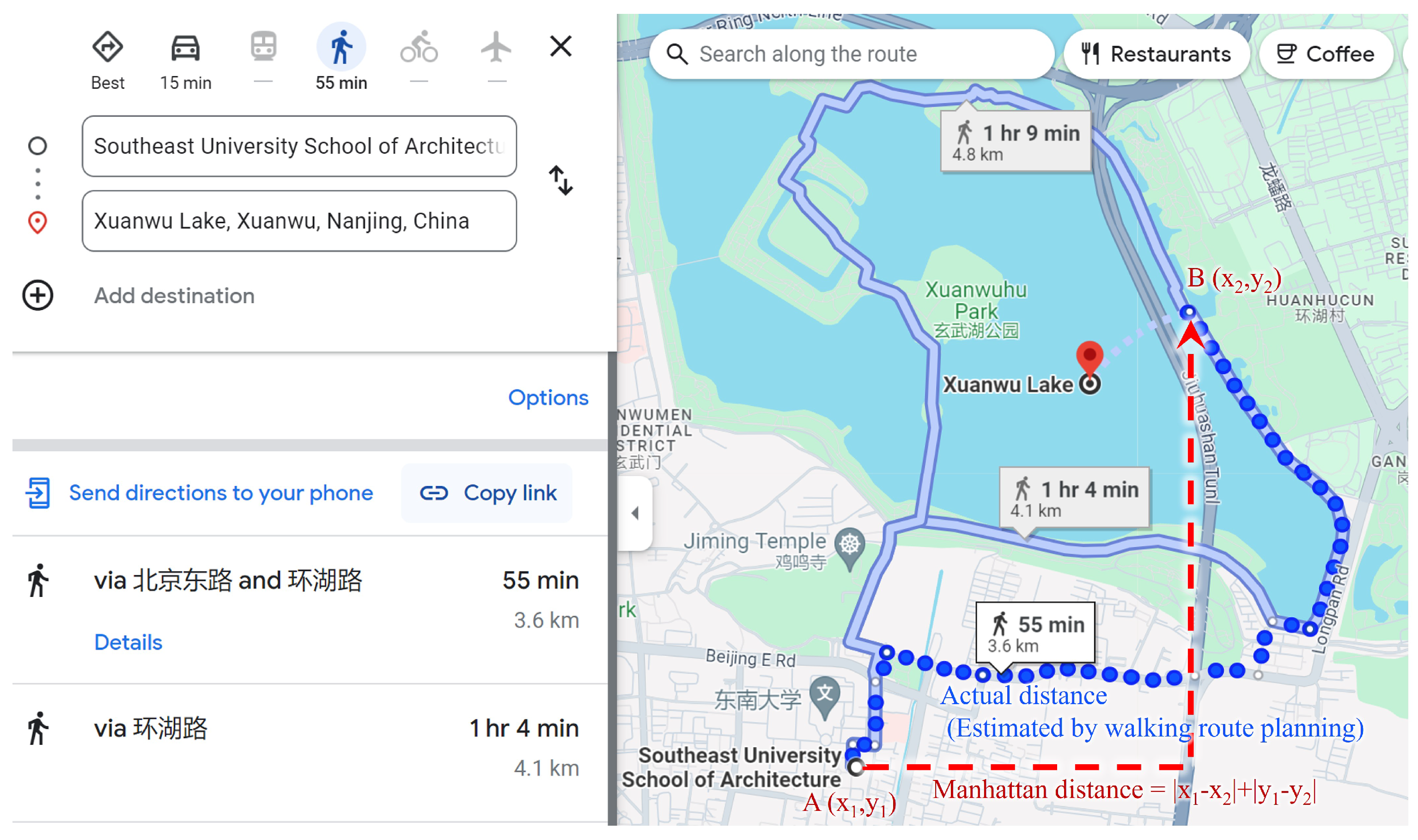
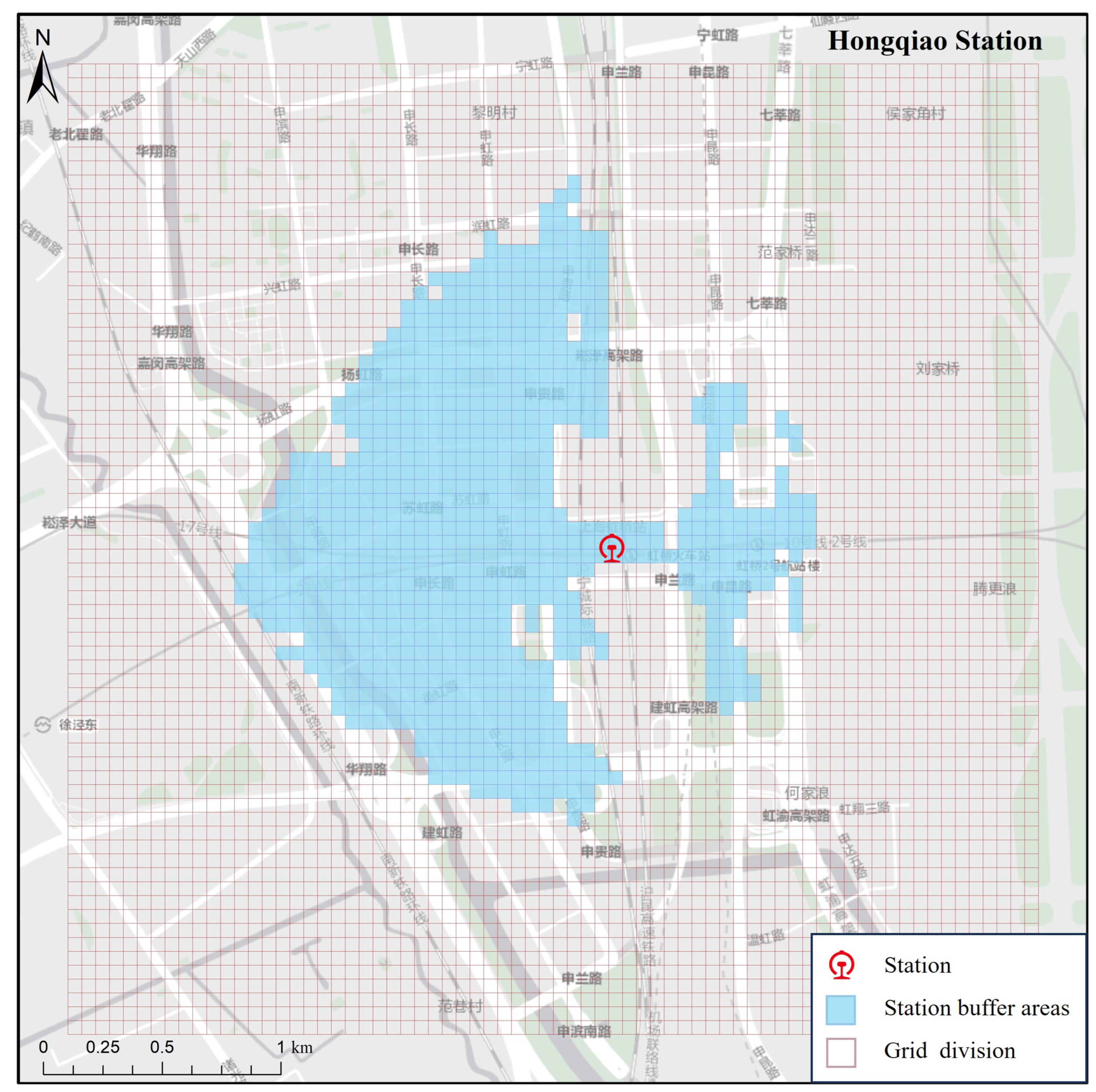

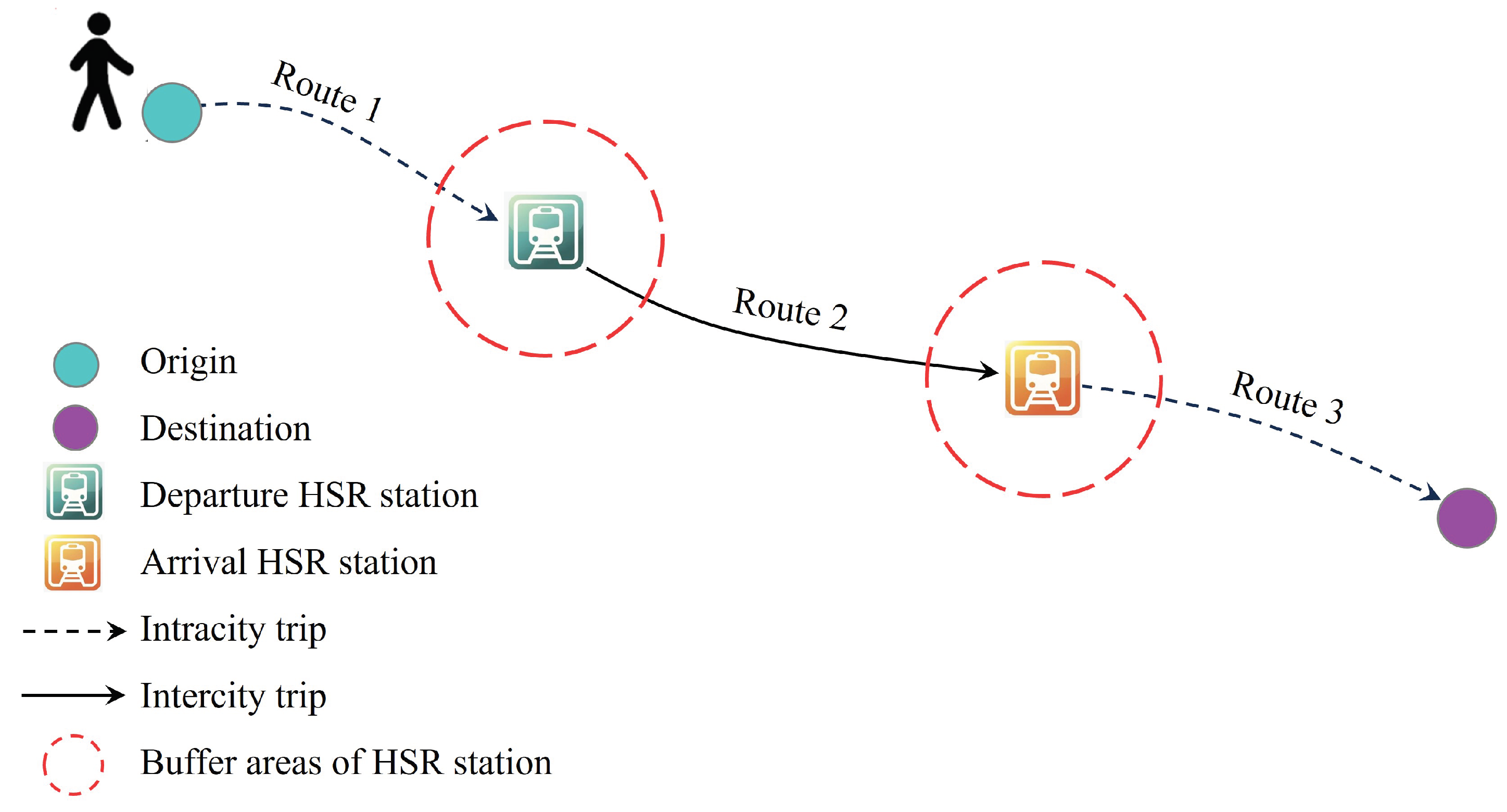
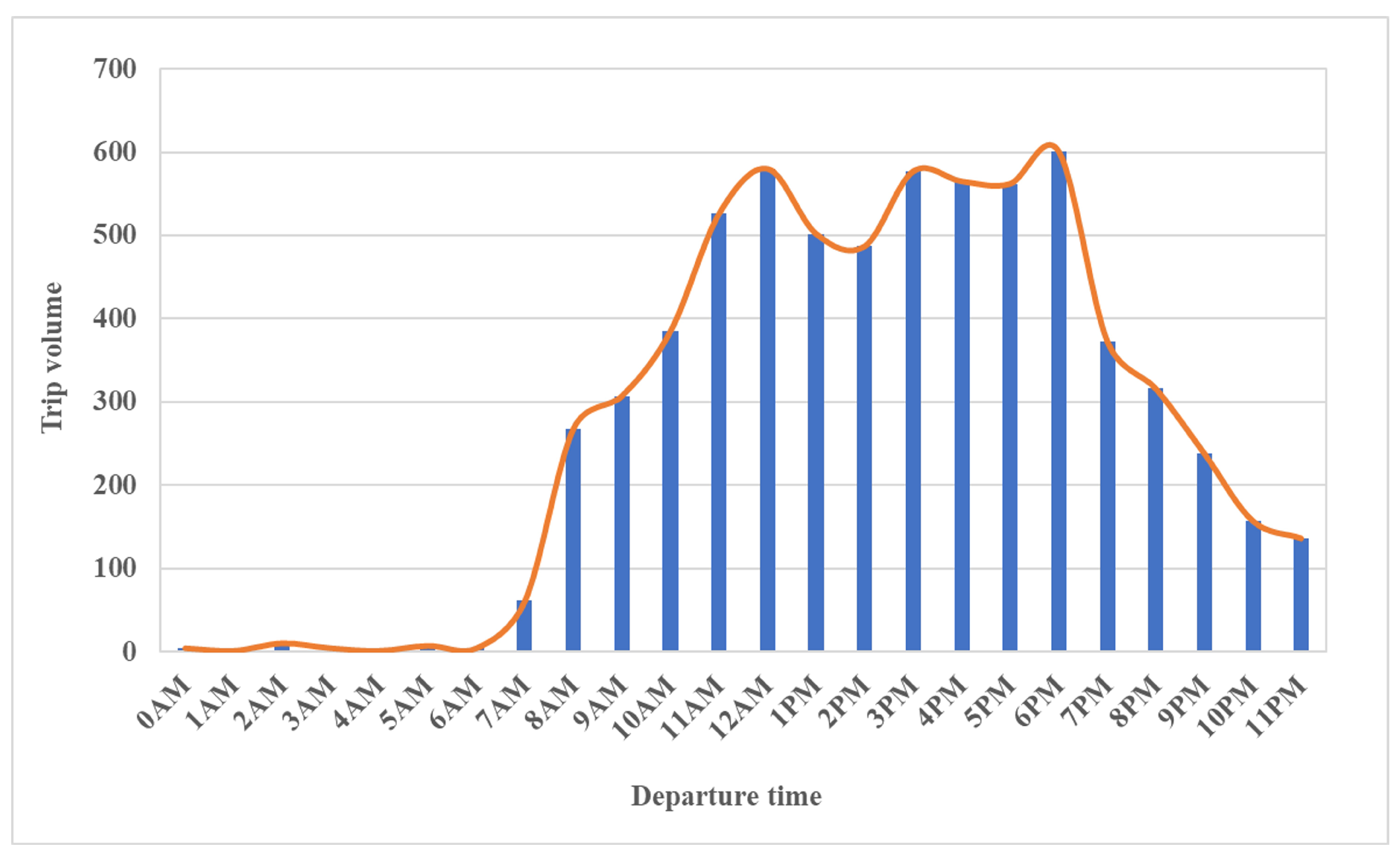
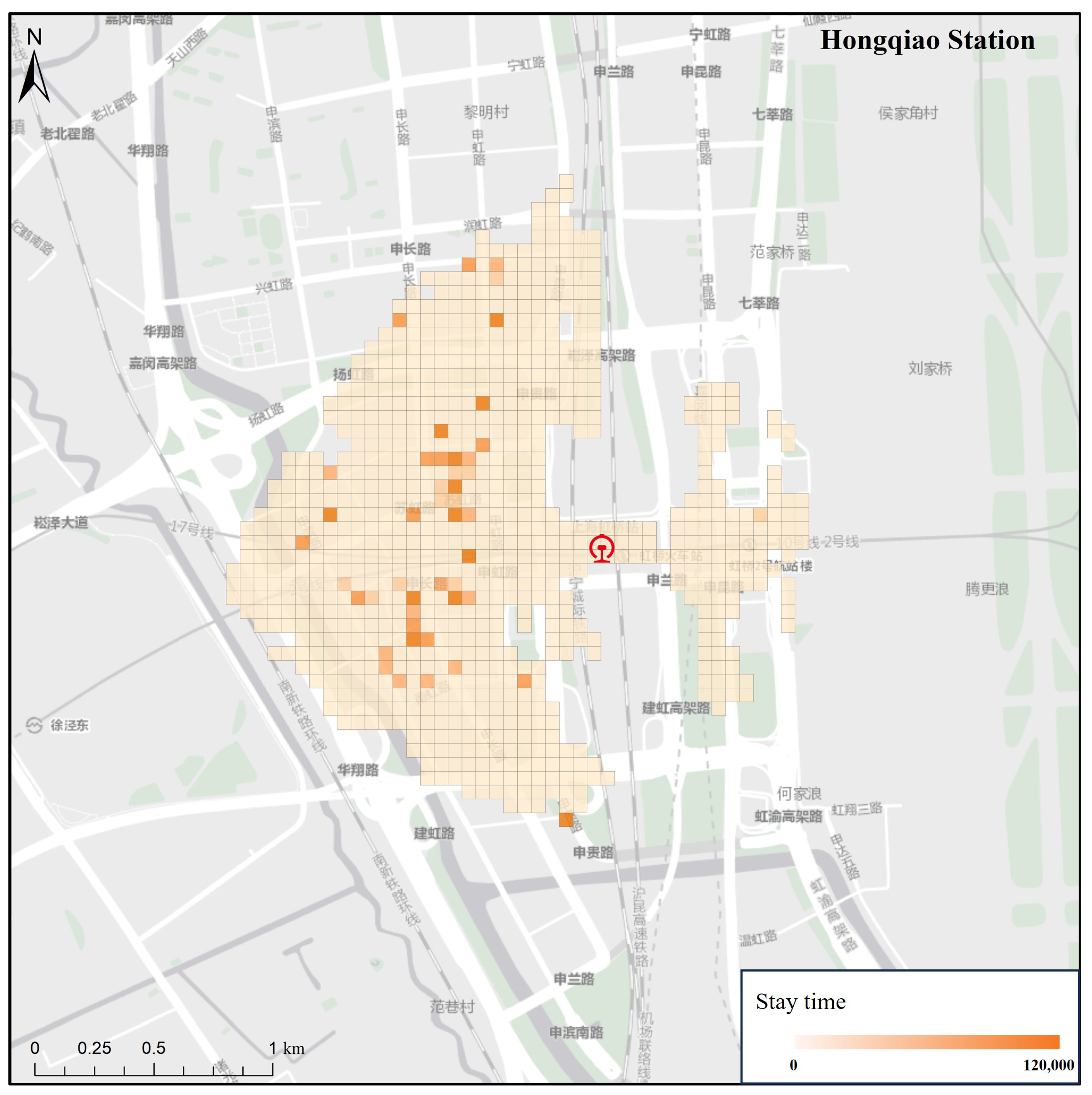
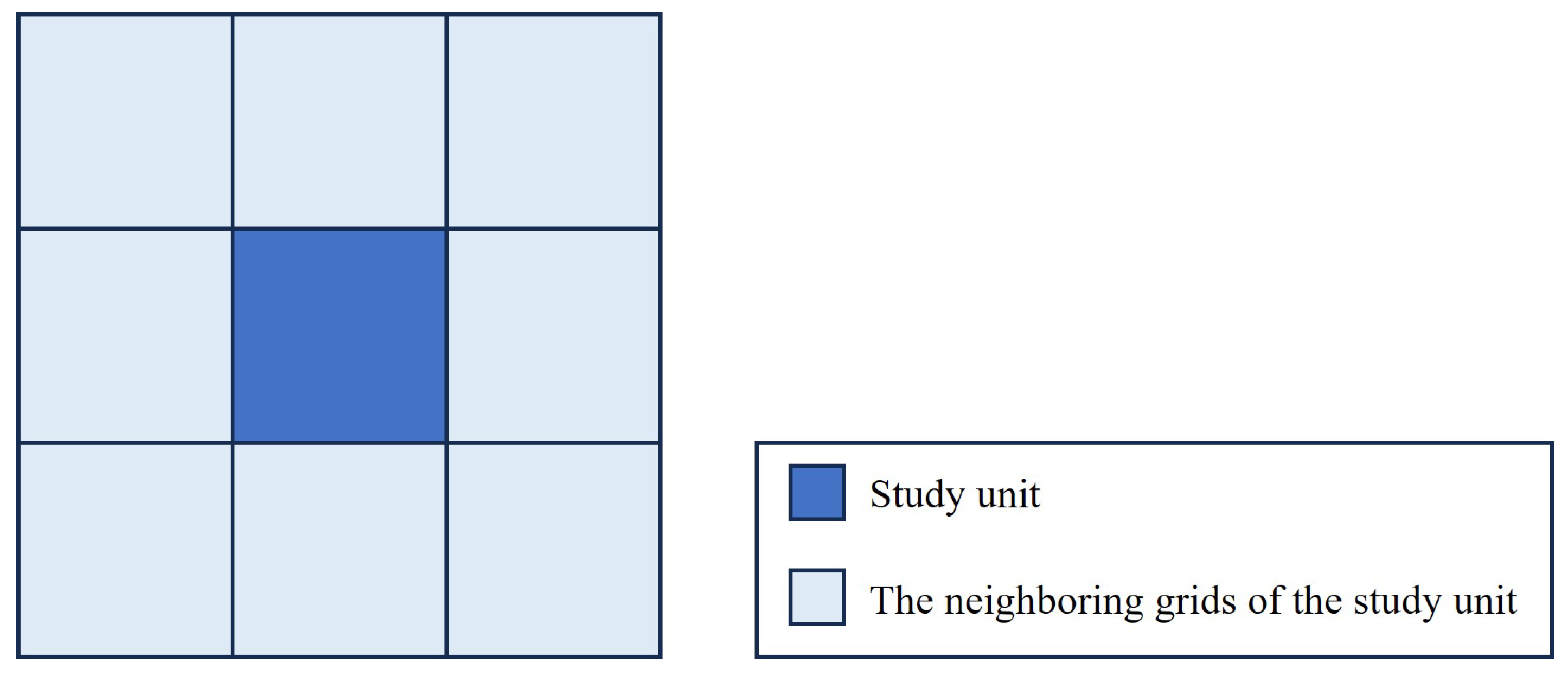
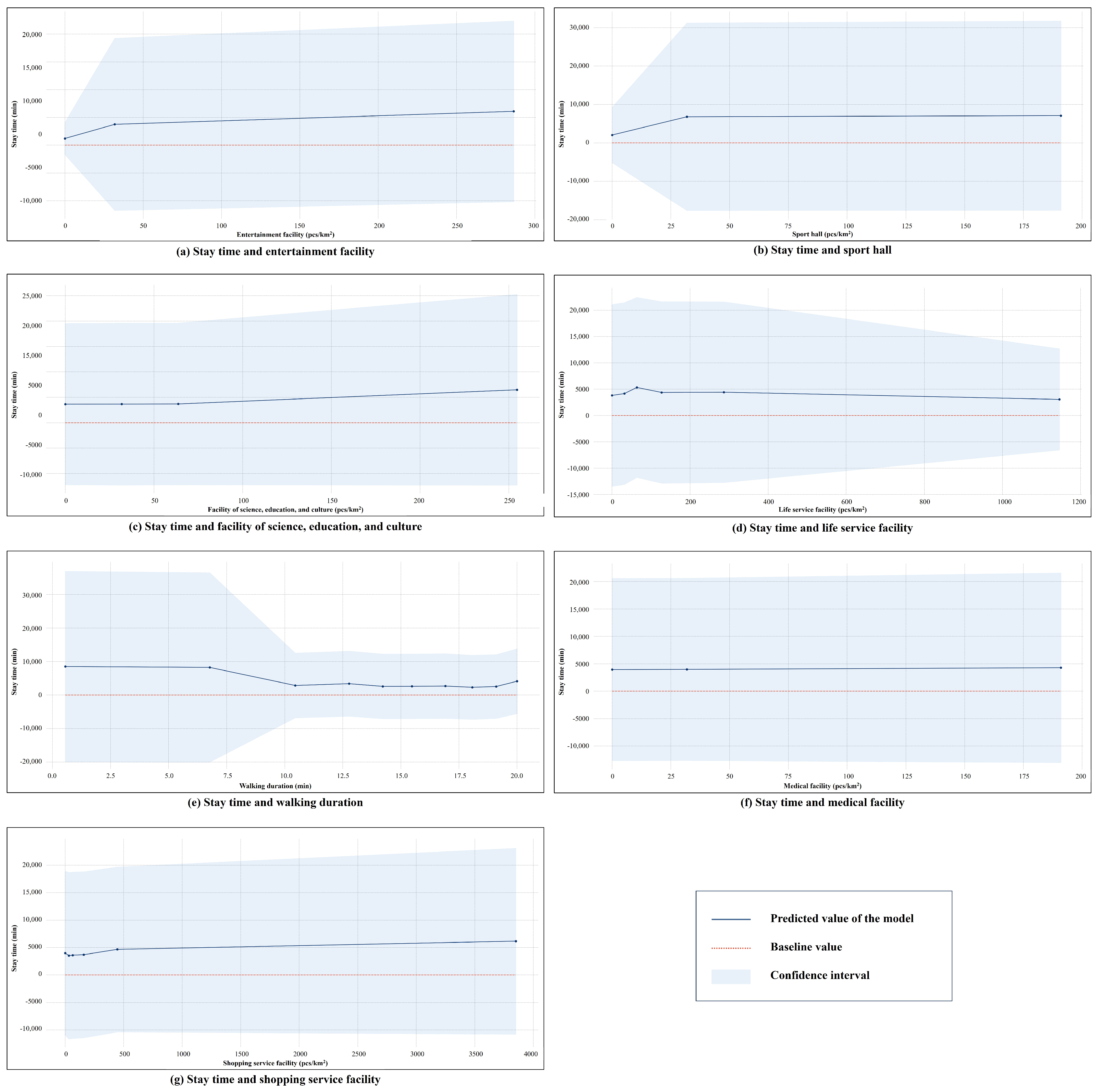

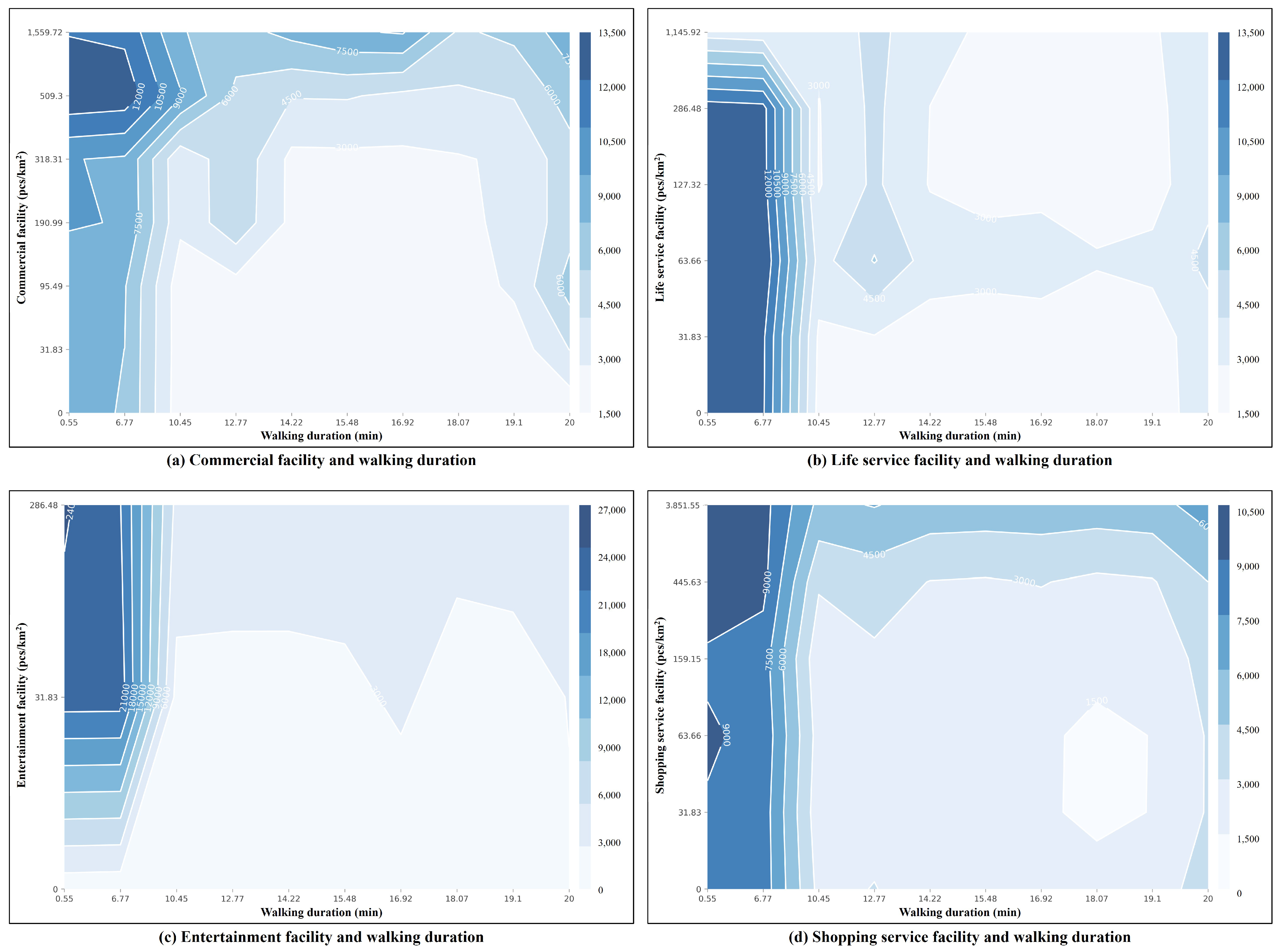
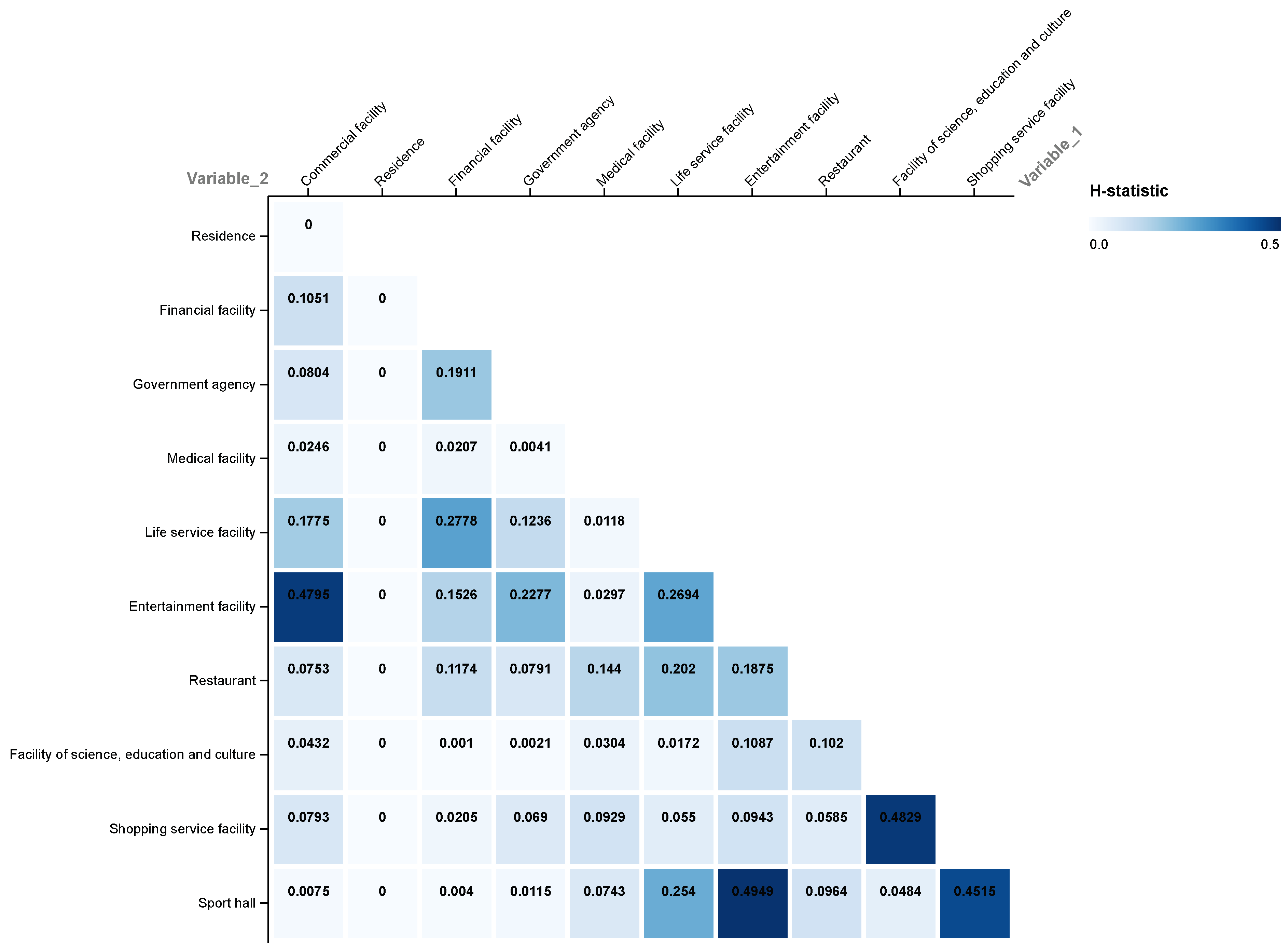

| Field Name | Description | Sample Data |
|---|---|---|
| ID | Identification number of user | 00005438-**** |
| Lat | Latitude of stay point | 121.31556 |
| Lng | Longitude of stay point | 31.19592 |
| Start_time | Start time of stay point | 12 October 2022 13:04:26 |
| End_time | End time of stay point | 12 October 2022 13:04:32 |
| Stay time | Duration of stay point (min) | 0.1 |
| Field Name | Description | Sample Data |
|---|---|---|
| FID_POI | Identification number of POI | 431,096 |
| Name | POI name | Jiushixiaochu |
| Category | Category of POI | Restaurant |
| Subcategory | Subcategory of POI | Chinese food |
| Lat | Latitude of POI | 121.30934 |
| Lng | Longitude of POI | 31.180236 |
| Variable | Description | Min | Max | Mean | Std.dev |
|---|---|---|---|---|---|
| Stay time | The sum of HSR passengers’ stay time in each grid (min) | 0.00 | 126,498.10 | 3893.28 | 16,740.50 |
| Walking accessibility | The walking duration from the HSR station to each grid (min) | 0.55 | 20.00 | 13.86 | 4.77 |
| Commercial facility | The density of commercial facilities in each grid and its neighboring grids (pcs/km2) | 0.00 | 1559.72 | 182.49 | 4.77 |
| Financial facility | The density of financial facilities in each grid and its neighboring grids (pcs/km2) | 0.00 | 286.48 | 20.14 | 8.35 |
| Government agency | The density of government agencies in each grid and its neighboring grids (pcs/km2) | 0.00 | 159.15 | 10.13 | 1.27 |
| Medical facility | The density of medical facilities in each grid and its neighboring grids (pcs/km2) | 0.00 | 190.99 | 10.76 | 0.81 |
| Life service facility | The density of life service facilities in each grid and its neighboring grids (pcs/km2) | 0.00 | 1145.92 | 109.15 | 0.90 |
| Entertainment facility | The density of entertainment facilities in each grid and its neighboring grids (pcs/km2) | 0.00 | 286.48 | 11.24 | 6.21 |
| Residence | The density of residences in each grid and its neighboring grids (pcs/km2) | 0.00 | 31.83 | 1.30 | 1.17 |
| Restaurant | The density of restaurants in each grid and its neighboring grids (pcs/km2) | 0.00 | 2864.79 | 199.63 | 0.20 |
| Shopping service facility | The density of shopping service facilities in each grid and its neighboring grids (pcs/km2) | 0.00 | 3851.55 | 207.27 | 13.73 |
| Sports hall | The density of sports halls in each grid and its neighboring grid (pcs/km2) | 0.00 | 190.99 | 10.94 | 16.39 |
| Facility of science, education, and culture | The facility density of science, education, and culture in each grid and its neighboring grids (pcs/km2) | 0.00 | 254.65 | 20.52 | 0.87 |
| Variable | Relative Importance (%) |
|---|---|
| Entertainment facility | 45.11 |
| Sports hall | 38.50 |
| Facility of science, education, and culture | 8.62 |
| Life service facility | 2.09 |
| Walking accessibility | 1.96 |
| Medical facility | 1.94 |
| Shopping service facility | 1.10 |
| Commercial facility | 0.22 |
| Restaurant | 0.20 |
| Residence | 0.16 |
| Financial facility | 0.08 |
| Government agency | 0.02 |
Disclaimer/Publisher’s Note: The statements, opinions and data contained in all publications are solely those of the individual author(s) and contributor(s) and not of MDPI and/or the editor(s). MDPI and/or the editor(s) disclaim responsibility for any injury to people or property resulting from any ideas, methods, instructions or products referred to in the content. |
© 2024 by the authors. Licensee MDPI, Basel, Switzerland. This article is an open access article distributed under the terms and conditions of the Creative Commons Attribution (CC BY) license (https://creativecommons.org/licenses/by/4.0/).
Share and Cite
Cheng, J.; Hu, L.; Zhang, J.; Lei, D. Understanding the Synergistic Effects of Walking Accessibility and the Built Environment on Street Vitality in High-Speed Railway Station Areas. Sustainability 2024, 16, 5524. https://doi.org/10.3390/su16135524
Cheng J, Hu L, Zhang J, Lei D. Understanding the Synergistic Effects of Walking Accessibility and the Built Environment on Street Vitality in High-Speed Railway Station Areas. Sustainability. 2024; 16(13):5524. https://doi.org/10.3390/su16135524
Chicago/Turabian StyleCheng, Jianke, Liyang Hu, Jinyang Zhang, and Da Lei. 2024. "Understanding the Synergistic Effects of Walking Accessibility and the Built Environment on Street Vitality in High-Speed Railway Station Areas" Sustainability 16, no. 13: 5524. https://doi.org/10.3390/su16135524
APA StyleCheng, J., Hu, L., Zhang, J., & Lei, D. (2024). Understanding the Synergistic Effects of Walking Accessibility and the Built Environment on Street Vitality in High-Speed Railway Station Areas. Sustainability, 16(13), 5524. https://doi.org/10.3390/su16135524







